Blogginlägg -
7 ways to use social listening for customer service
Post summary:
- What is social listening?
- The business value of social listening
- 7 ways to use social listening for your business
Social media is now a part of our everyday life.
On average, we spend fifty minutes per day scrolling through news feeds, posting pictures, liking comments and sharing our experiences.
As more our attention shifts to social media, companies are doubling down on their investment into social media as they look to use this channel to grow their business.
In the past, this meant creating a brand page and using social media to promote their business. But, that’s no longer the case, as companies are increasingly using social media to handle customer service requests.
Instead of being a communication platform, social media has become a customer experience platform.
In fact, 65% of customers now use social media for customer service.
This shift means that the power is firmly in the customers hands. Your customers are contacting you in a channel that they prefer – and they expect you to respond.
But, what happens if you don’t respond? Well, simply put – your customers will stop doing business with you.
A study by Gartner found that companies that do not respond to social media messages face up to a 15% increase in customer churn.
Furthermore, an American Express study found that 83% of consumers had not completed a purchase due to a poor customer service experience on social media.
Can you afford to lose customers?
If not, then it’s time to stop ignoring social media as a customer service channel.
Of course, it’s easy to think that if a customer has a problem, they will message you directly. But, that’s not the case.
In a study of more than 35 million tweets, Mention found that only 9% of customer service messages are directed at brands on social media. Worse still, 30% of customer service messages do not mention you by name at all!
This means that there are messages directed at you on social media right now, waiting for a response. And you need to find them. But, how?
You do this through social listening.
What is social listening?
Social listening is the process of finding and contributing to conversations about you or your brand online by seeking out brand mentions, specific keywords or phrases and comments. Like social selling, social listening is about being where the conversation is – on social media.
By listening to conversations, you can participate, educate and build relationships with prospects and customers.
Why is social listening important?
When a customer stops doing business with you, it’s not because of price or product, it’s because of the service you provide. If you don’t respond to their messages online, then they don’t feel valued. It’s at this point, that they decide to shop elsewhere.
A study by American Express found that when a customer has a poor customer service experience, they share that experience with 17 people. However, when a customer has a poor customer service experience on social media, they share that negative experience with 53 people!
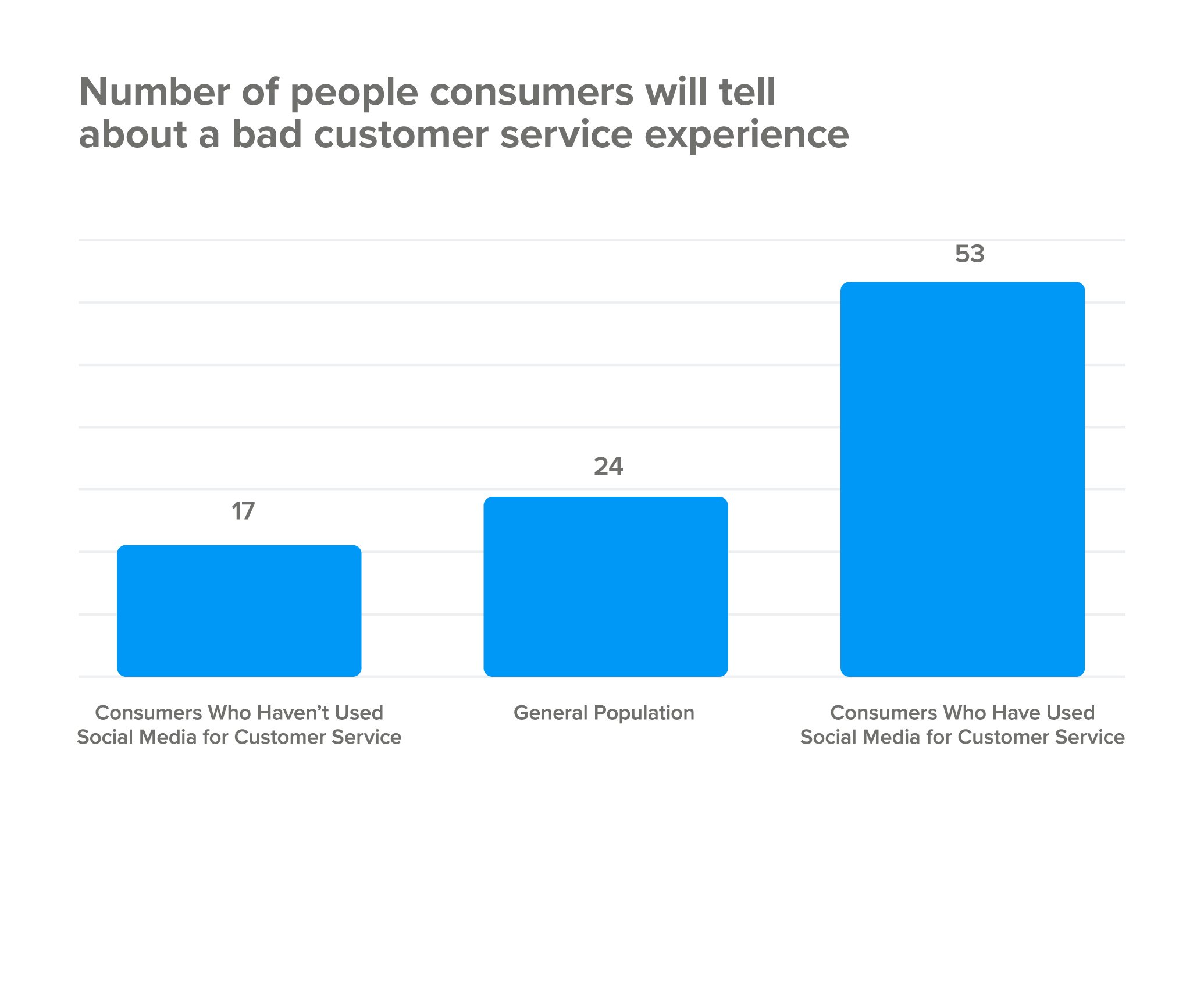
That’s right – a poor customer service experience on social media is shared with twice as many people!
Unfortunately, the negative impact doesn’t end there as one poor experience that is shared publicly can undo the effect of up to 5 positive experiences. There’s no faster way to lose business than to ignore your customers.
Putting the customer at the heart of your business is important, but there’s direct business benefits tied to social listening as well.
The benefits of social listening are as follows:
- It increases average spend per customer. A study by Bain & Co. found that when companies respond to customer service messages on social media, those customers spend between 20% to 40% more with the company.
- It reduces operational costs. A study by Brand Watch found that handling customer service requests via social media channels is up to 12 times cheaper than handling the same requests by phone. McKinsey & Co. also found that shifting to social media customer service can reduce cost per contact by as much as 83%.
- It gives you a competitive advantage. Research by Social Media Marketing Universityfound that 76% of brands do not participate in social listening. And of the brands that do participate, only 38% actually respond to their customers.
- It results in greater job satisfaction rates. According to Sparkcentral, 68% of companies say that the agents that are dedicated to social media customer service show greater job satisfaction rates than agents assigned to phone and email support channels.
Through social listening you can increase revenue, earn higher customer satisfaction rates and reduce customer support costs – everything you need to successfully grow a business.
But, how do you do social listening?
Social listening is more than logging in to your Facebook page and checking the notification tab every 10 minutes. You need a social listening strategy, which begins by choosing the right network and tools and then, you can start to participate in conversations online.
7 ways to use social listening for your business
To get started, you set up and track conversations about your brand online. Then, you need to find and respond to messages directed to you and the messages that were written for you, but you have not been notified. Once that is in place, you then need to respond accordingly to each message.
Before that, we’ll dive into social media usage.
1. Find the social network(s) you want to listen in on
As new social media networks emerge, it can be difficult to decide which channels you want to listen in on. The easiest way to decide is to choose the channels your customers are most active on.
So, how do you find which social networks your customers are on?
You start by looking at the social media usage demographic data.
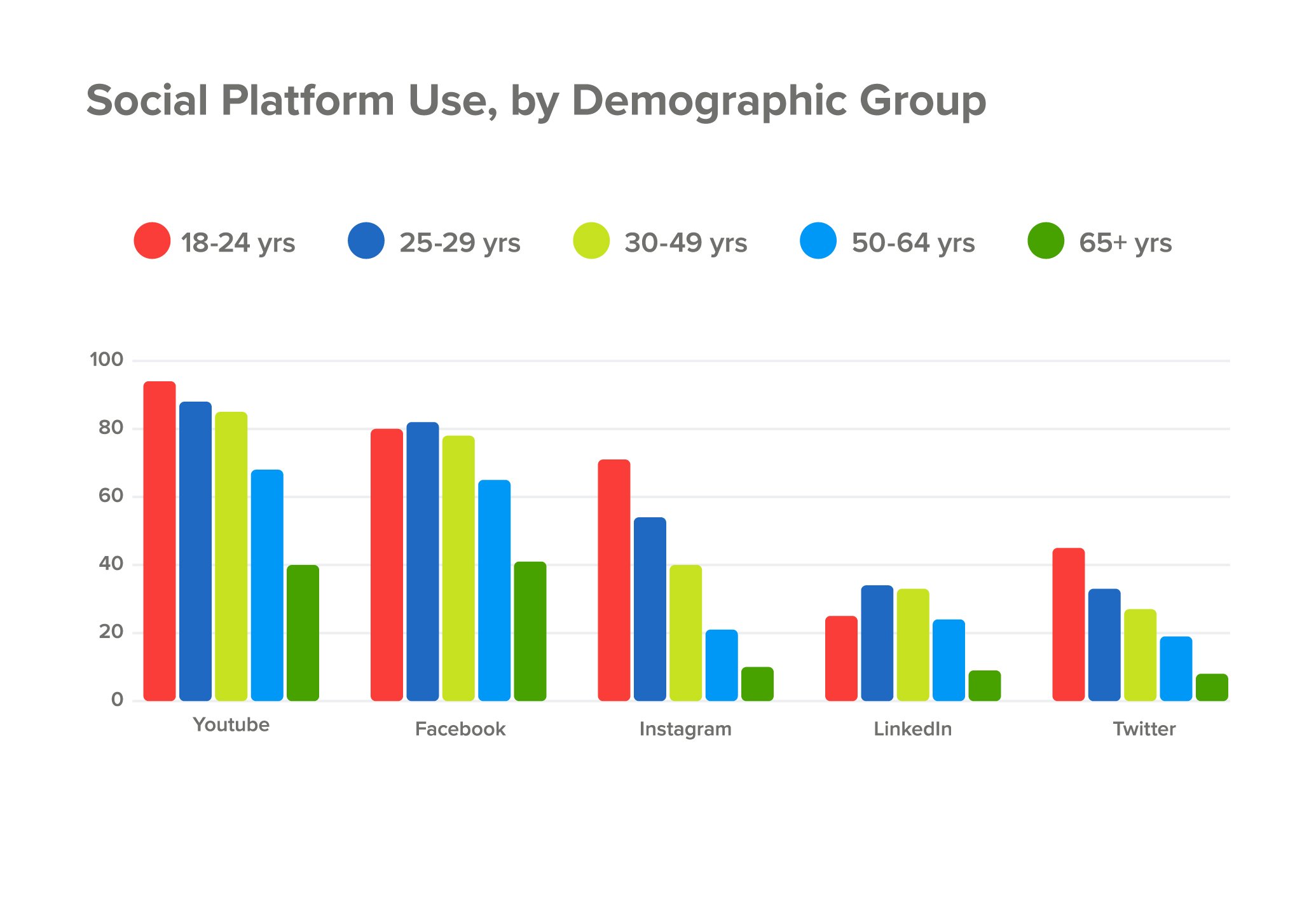
Are your customers aged between 18-30 years old? Then start with social listening on Facebook and Instagram. If you’re in B2B sales and your target customers are 30-50-year-olds, then start listening to conversations about your brand on LinkedIn.
Try not to overextend yourself, especially in the early stages of social listening. Start with only one or two social networks in the beginning in order to understand the best way to use it for your business.
2. Choose the social listening tools you want to use
To be successful in social listening, you need to use the right tools. Fortunately, there’s a wide range of social listening platforms that offer paid and free tools you can use to track, monitor and notify you when conversations are happening.
- Google Alerts allows you monitor the web for brand mentions, keywords and phrases. It’s simple to get started and is usually the first point of call for any social listening strategy.
- Hootsuite is one of the most popular tools in social media monitoring. With Hootsuite, you can monitor keywords and phrases across all major social networks, including Facebook, LinkedIn, Twitter and Google+.
- Mention helps you keep track of brand mentions on social networks, blogs, websites and forums and all in one easy to use inbox-like user interface (we use Mention at SuperOffice).
- Followerwonk helps you find, analyze and optimize your social media presence on Twitter. You can use Followerwonk to find social media influencers by searching Twitter accounts for specific keywords, location and follower count.
- Social Mention analyzes more than 100 social media websites and provides in-depth reporting, making it a great choice for brands that are active on multiple social networks.
- SuperOffice Service is a help desk solution that tracks all social media messages directed to you in one location (a CRM), which allows your customer service team to respond immediately.
3. Set up alerts and notifications for real-time updates
To find conversations online, you need to set up alerts and notifications, so you can receive real-time updates each time a conversation takes place, allowing you to participate as needed.
The most important alert you need to create is your brand name. At SuperOffice, we’ve set up tracking for conversations around “SuperOffice” and misspellings that are being discussed online. Each time our brand name is mentioned, we receive a real-time notification (as shown in Mention below).
![]()
You can also create alerts for brand slogans, your CEO’s name, campaign names or keywords and even industry buzzwords. Another alert could be your competitors’ names, which allows you to see (or spy on, depending on how you look at it) what your competitors are sharing on social media or what their customers are saying about them.
Now that you are set up to track conversation online, it’s time to get involved with them.
However, finding conversations online about your brand isn’t the difficult part. It’s choosing which conversations to participate in and which conversations to simply take note of or “like”. The smartest conversations to start engaging in are customer service requests and customer complaints.
4. Respond to customer requests
More than 65% of consumers have used a company’s social media channel for customer service, according to a study by J.D. Power.
Yet, only 38% of companies respond to customers on social media!
Not responding to customer service requests is a customer service sin.
So, first things first, you need to respond.
If you find a customer service question or comment on social media, respond to it as quickly as possible.
While analyzing more than 1 billion mentions online, Mention.com found that 67% of all company mentions occurred on Twitter, which is why many of the examples of social listening (like Seamless, below) include references to Twitter.
The good news is that these social listening strategies apply to all social media networks.
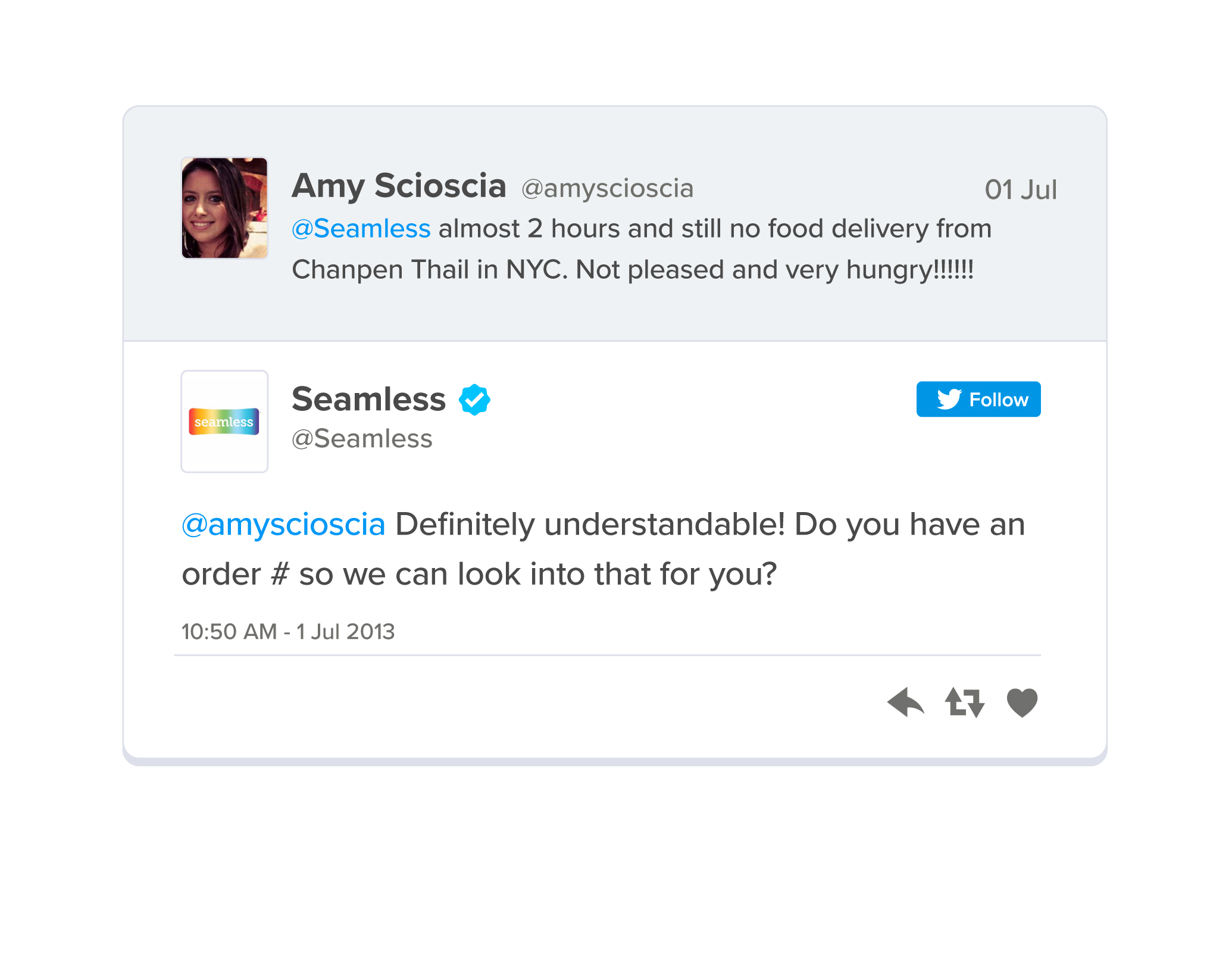
If you’re unable to answer immediately, acknowledge the customer and inform them that you will respond as soon as possible.
The key to responding on social media is speed.
On average, customers expect a social media response within 60 minutes.
Yet, research by Convince and Convert found that response times in social media range from 15 minutes to 24 hours!
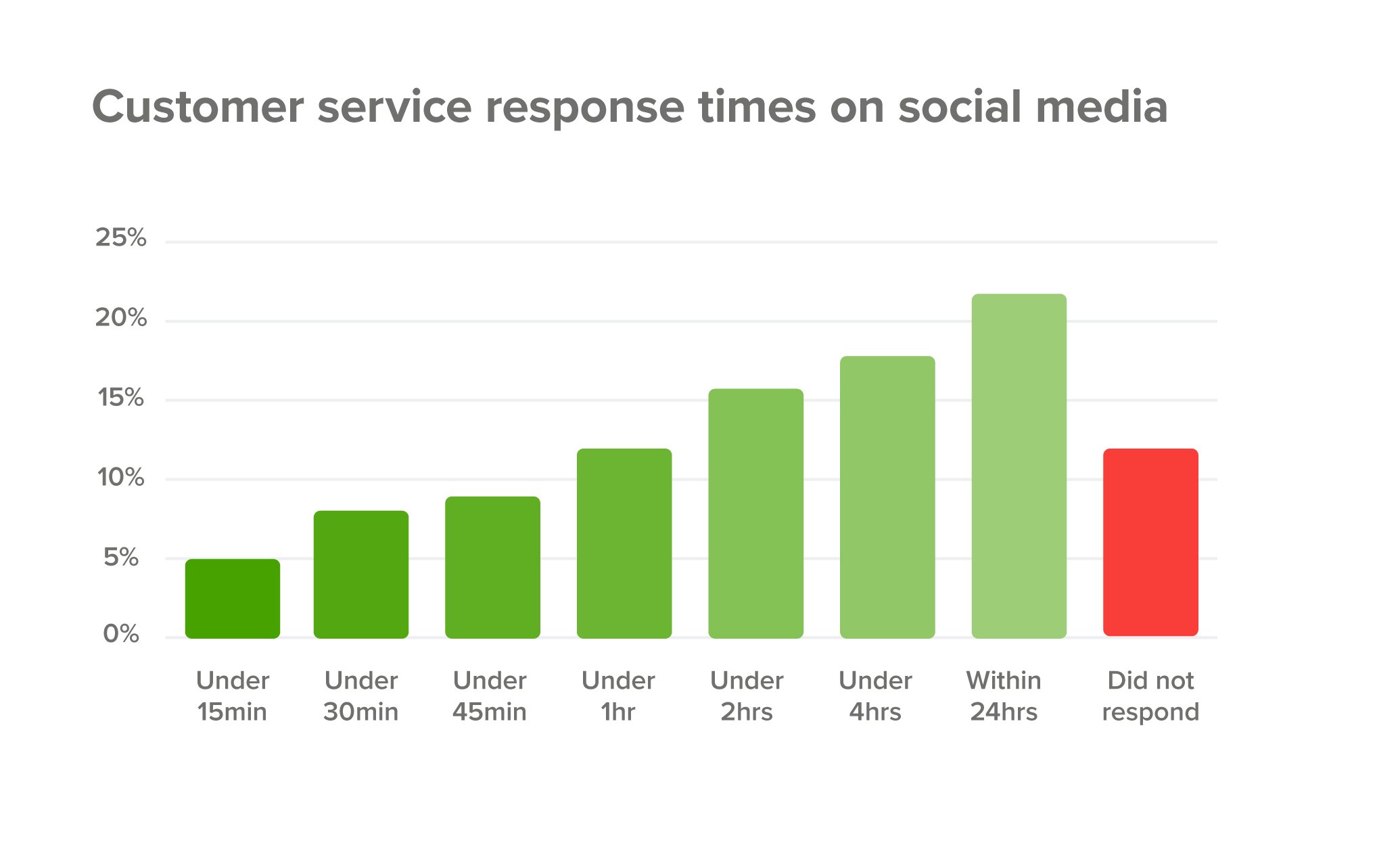
This is why it’s important to set up tracking and use the right tools before we start social listening. Social media monitoring tools report in real-time and you will be notified each time a conversation takes place – giving you the competitive edge to respond well within 60 minutes and exceed customer expectations.
5. Handle customer complaints
When a customer has a bad experience, 31% of them turn to social media to complain about it.
Unfortunately, 21% of those complaints never receive a response.
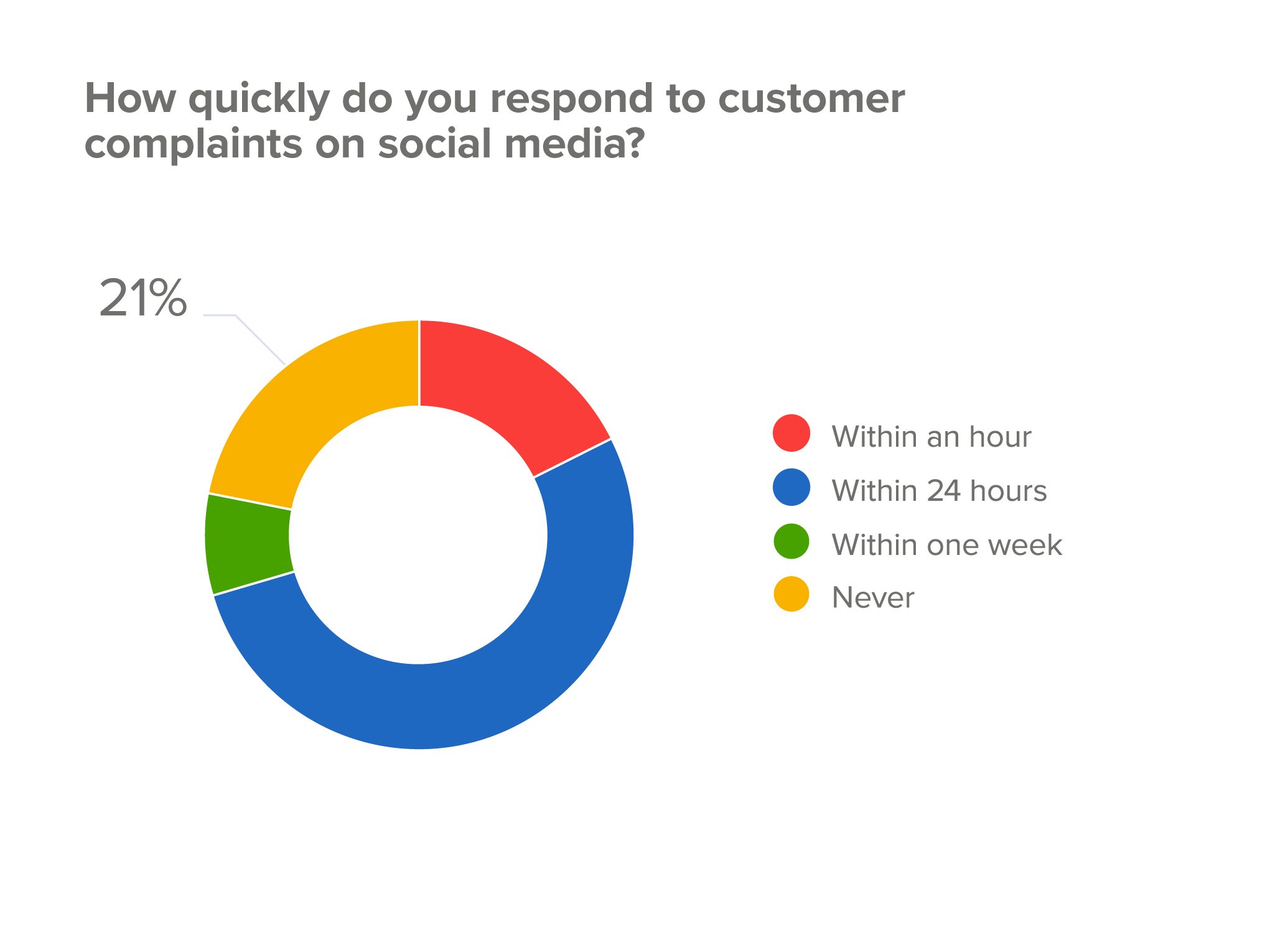
If you find a complaint on social media, address the complaint as quickly possible and apologize.
Why apologize, you ask?
It’s because research by The Nottingham School of Economics found that customers who complain are more willing to forgive a company that offers an apology than being offered compensation.
Where possible, try to take the conversation offline by asking for an email address or phone number to discuss the nature of the complaint (rather than in snippets of 280 characters!), as shown in the example below from T-Mobile:
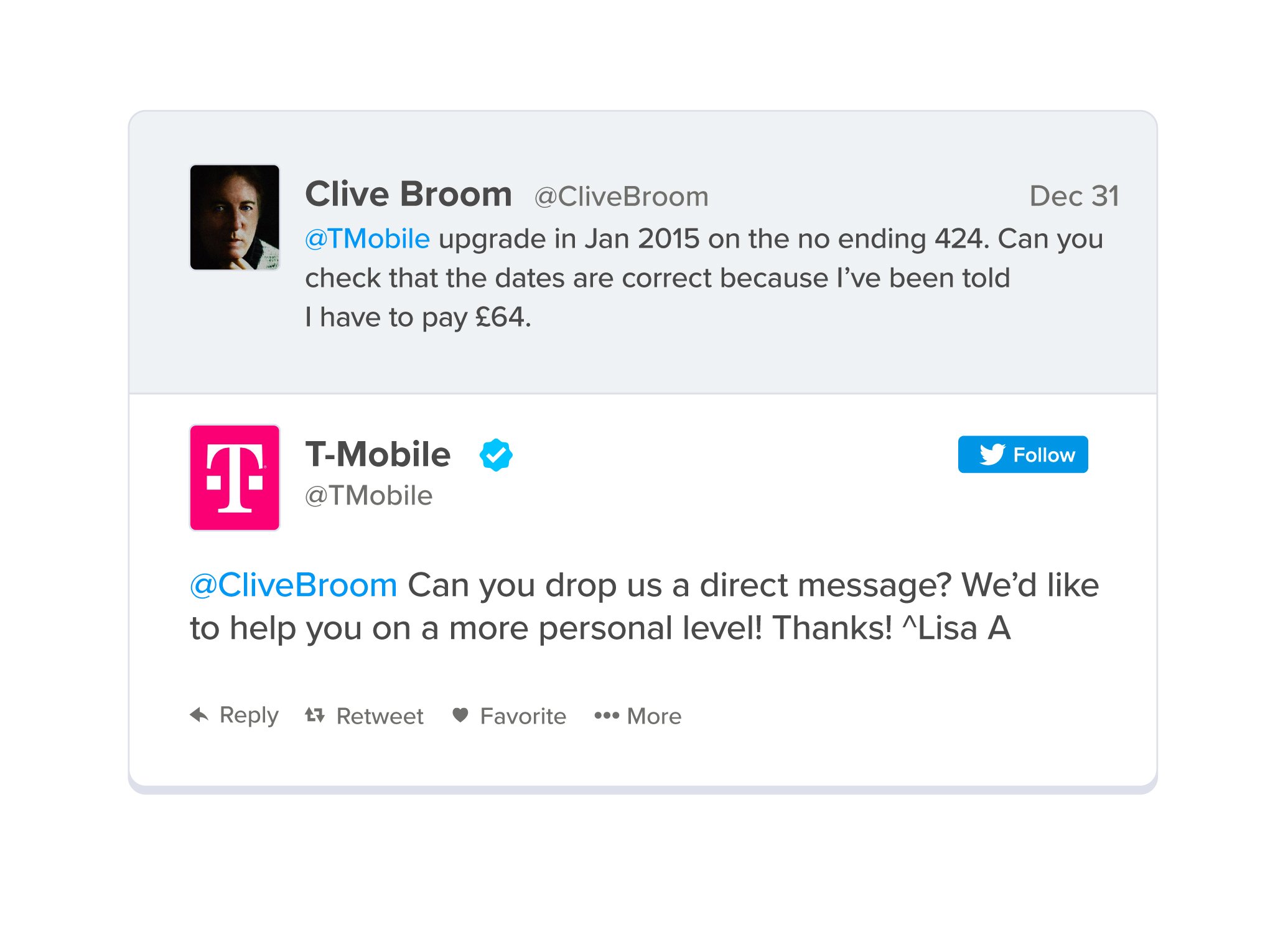
6. Acknowledge positive feedback
Not all conversations about your brand will be negative.
In fact, some of the best feedback you can get can be found on social media – whether it’s someone sharing your latest white paper, recommending your product or simply liking your Facebook post.
So, don’t ignore them!
Any engagement you receive on social media should be acknowledged.
And that can be as easy as just saying “thank you”.
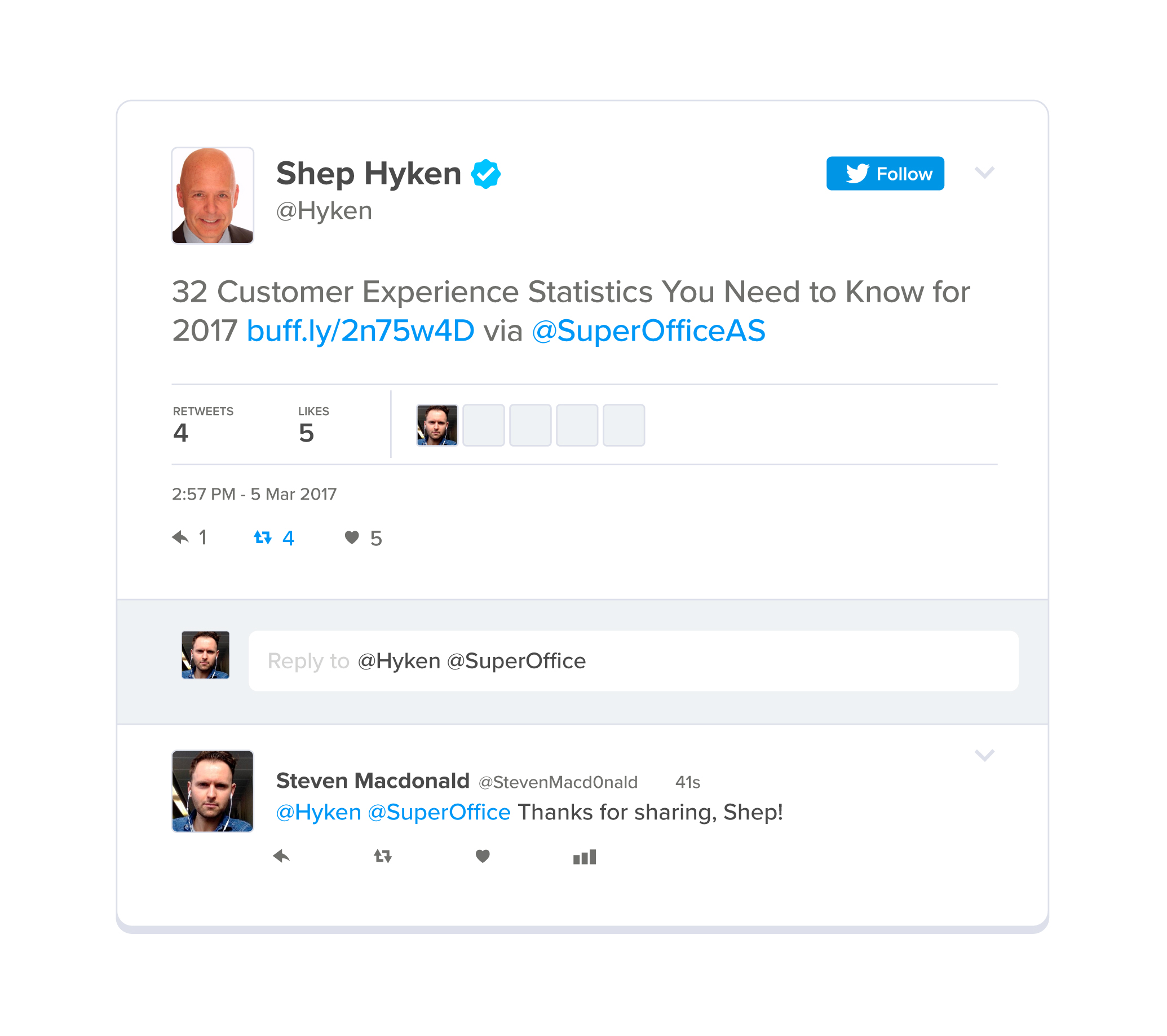
In the example above, the social media user who shared a SuperOffice blog post turned out to be non-other than Shep Hyken – a customer service expert who has more than 118,000 followers on Twitter!
The Journal of Business & Economics Research found that 42% of social media users have purchased a product based on a recommendation from someone they are following. Therefore, the more people that promote your brand online, the faster your business will grow – so it pays off to engage with them whenever you can!
7. Be proactive in social listening
One of the best ways to provide customer service is to solve a customer’s problem before they know about it, which means shifting from a reactive approach to customer service to being proactive.
What does proactive social listening look like, you ask?
Well, if you have scheduled a software update for your product that requires the product to be offline, being proactive can be as easy as sharing this information with your audience, like IT Services did below:
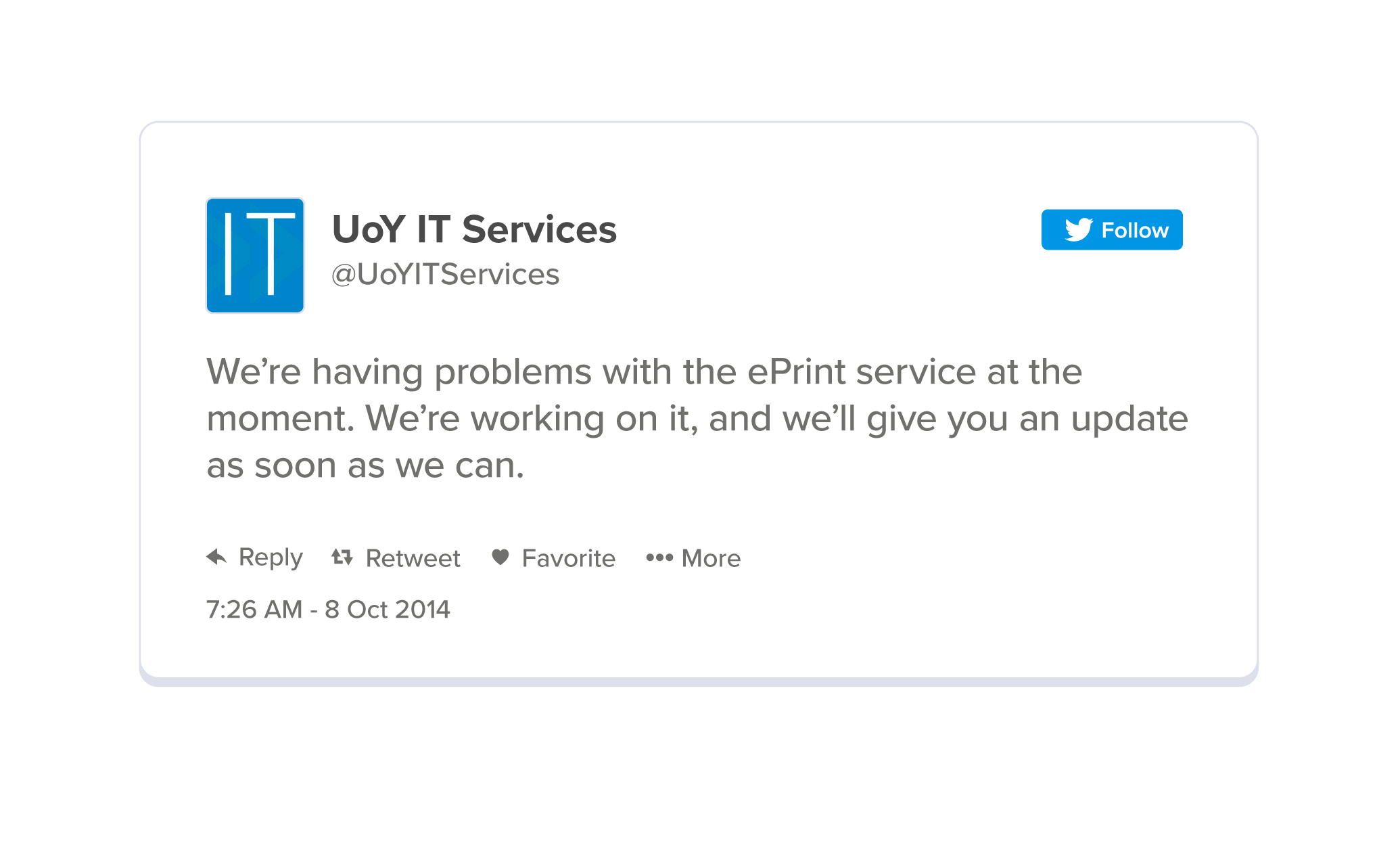
Here’s another example:
If you find that a customer shares a complaint on social media that he or she has trouble logging in to your product, you can handle this proactively by resetting their password and sending them the new details by email.
Proactive customer service offers a number of benefits for your business. For example, companies that invest in proactive support increase customer retention rates by 3-5% and can lower their operating costs by up to 25%.
Conclusion
Social listening is an important part of customer experience, which makes it a valuable strategy for any business.
Through social listening, you will gain a competitive advantage, exceed customer expectations and increase revenue. However, you can only achieve this if you have the right strategy in place. This means choosing the right networks to monitor, using the right tools to track conversations in and then prioritizing support resources to respond in real-time to tweets, comments and posts about you and your brand.
So, if you’re looking for new ways to deliver a great customer service, try social listening.
Just remember the golden rule: Less talk. More listening.
What do you think of social listening?
Have you seen the benefits since implementing a social listening strategy?
Let me know below.
P.S. If you enjoyed reading this article on social listening, you can share it with your audience here!
Ämnen
- Data, Telekom, IT
Kategorier
- kundservice
- crm
- blogg